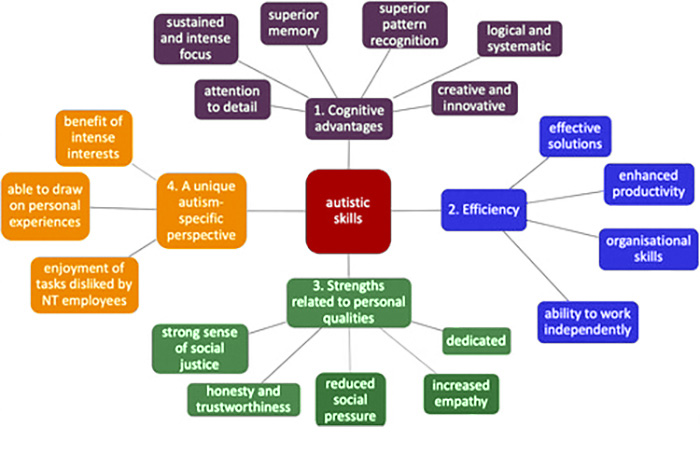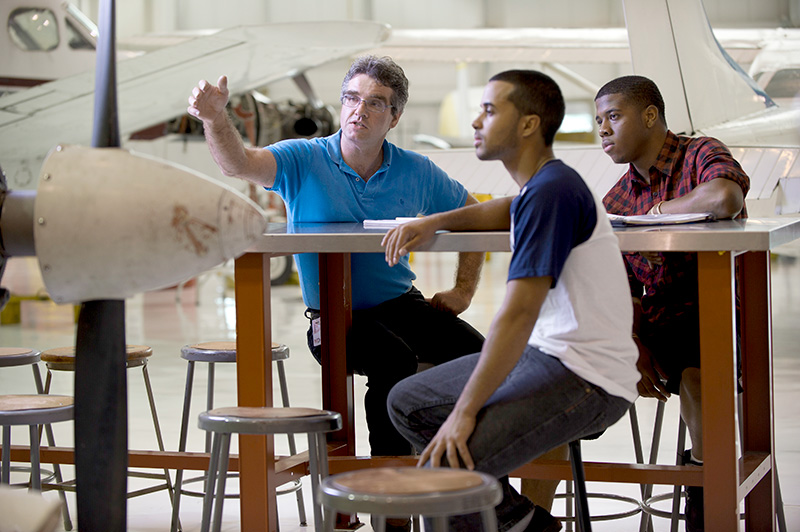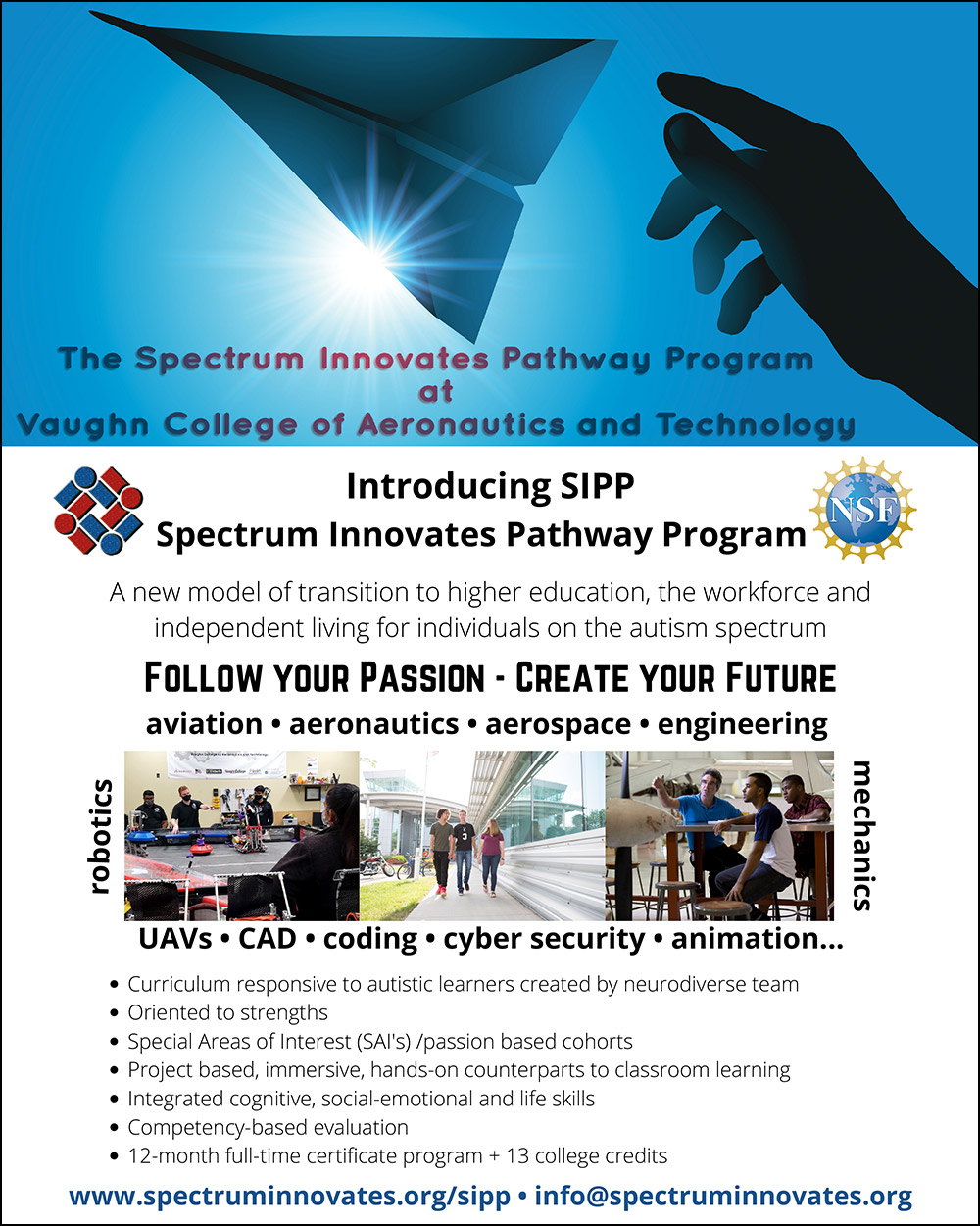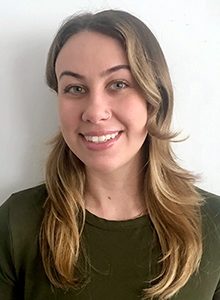Technology can support autistic people in many ways, but autistic people also have so much to offer in the field of technology. Autistic people with an interest in STEM-related fields (Science, technology, engineering, and mathematics), combined with their natural cognitive and character strengths, create a recipe for innovative and dedicated advanced technicians. Long-gone are the days of centering autism only as a deficit. Within the neurodiversity framework, autism is viewed from a social model of disability. This means that there are incongruences between the environment and needs of the autistic person. Solutions should focus on uplifting strengths and making accommodations and modifications to the environment to best support someone’s functioning (den Houting, 2019; Cope & Remington, 2021).

Figure 1. Autistic skills and strengths (Cope & Remington, 2021).
Within this perspective, it is important to create space for conversations that center on autistic strengths. There’s no doubt that existing as an autistic person in a world built for neurotypical people can be challenging. As Dr. Stephen Shore said, “If you’ve met one autistic person, you’ve met one autistic person,” meaning every autistic person experiences their unique blend of autism traits differently. Although this is true, current research from employed autistic adults reveals self-identified patterns of strengths in certain cognitive, emotional, and personal qualities that are commonly experienced by autistic people (Cope & Remington, 2021). With that, there should be many opportunities for autistic people to work in a supportive, neurodiversity-affirming environment that allows you to use your authentic, autistic strengths.
Special Interests and Strengths
Harnessing special, or focused, interests can be an entry point for autistics in their field of employment. For me, when I first stepped into my 12th grade psychology class and learned about the different areas of the brain, what motivates people, and the many other ways we as humans have been studying our own minds, emotions, and behaviors, I was hooked. Although at the time I didn’t know I was autistic, I had an unexplainable desire to understand others. Almost 9 years later I have a bachelor’s in psychology, a masters in cognitive science in education, and a range of research and clinical experiences that have all been fueled by my special interest of psychology. Now, this is not the case for every autistic person. Anecdotally, many autistic people find employment in fields that differ from their special interests. Many special interests are a reprieve from the outside world, a chance to go inward and learn, practice, and repeat; rebel against a desire to perform and produce. But it is an option if you envision a career related to a long-time special interest. It is also a way to engage and motivate autistic learners. With a special interest in a STEM-related topic, autistic students may have an inherent drive to learn about these topics which can lead to very successful vocational outcomes (Forman, 2021; Kaboski, 2014).
Autistic people possess many strengths that can benefit the technology industry. These strengths have been identified by both autistic people themselves, employers, and researchers (Cope & Remington, 2021; Russell et. al., 2019; Attwood, 2015). These strengths include but are not limited to pattern recognition, logical and systematic problem-solving, attention to detail due to enhanced local processing, sustained focus, innovation, creativity, offering a unique perspective, honesty, loyalty, and dedication (Cope & Remington, 2021; Mottron et al., 2006). See Figure 1. above: Autistic skills and strengths, a diagram from Cope & Remington’s 2021 study, The Strengths and Abilities of Autistic People in the Workplace. Within the field of technology, pattern recognition, logical and systematic problem-solving, and attention to detail can be invaluable skills. The personal qualities of honesty, trustworthiness, and dedication are excellent qualities of employees. These cognitive skills and qualities are being noticed by top companies. Corporate leaders have identified the autistic community as having unique untapped talents, skills, and creativity. Microsoft, Ford, SAP, DXC, and JPMorgan Chase, members of the Autism at Work consortium, affirm that companies that can effectively tap into this talent pipeline will hold a competitive advantage.
Creating Educational Opportunities for Successful Employment
The ever-changing needs of technology roles today require broad knowledge and technical skills that can be applied in a wide range of roles. “The jobs of today are more machine-powered and data-driven than in the past, and they also require more human skills in problem-solving, communication, interpretation, and design” (Center for Occupational Research and Development, 2021). It is crucial that we create educational opportunities that prepare students to not only gain employment but enter these roles successfully.
Unfortunately, approximately 85% of autistic adults are underemployed or unemployed nationally (Roux et. al., 2017). There is a gap between autistic potential and successful opportunities for application of skills towards employment. Transitioning into adulthood and successful employment is a difficult period of life for anyone. There are many shifts in ways of thinking, new responsibilities, and changing relationships. The difficulties experienced with autism such as differences in communication styles between allistics (i.e., non-autistic people) and autistics, social engagement, and other developmental delays creates more roadblocks towards employment (Milton, 2012; Baker-Ericzen et al., 2017).

Students learning in Vaughn College’s hanger
Autistic students age out of services governed by the Individuals with Disabilities Education Act (IDEA) between ages 18 and 22, and the social welfare laws mandating specialized services end abruptly – “falling off the cliff”- destabilizing their lives. Families are further overwhelmed and left scrambling to find programs for their children that lead to employment. Existing programs are often based on a deficit model rather than harnessing strengths and do not facilitate the development of essential social emotional and life skills required for sustained competitive employment (Koenig & Williams, 2017; Fletcher-Watson & Happé, 2019).
Bridging the Gap With the Spectrum Innovates Pathway Program
So, the question remains, how do we bridge the gap and create a pathway for autistics interested in STEM to bring their strengths and unique perspective to technology roles? Our team at Spectrum Innovates is creating an experiential, hands-on, immersive transition program, Spectrum Innovates Pathway Program (SIPP), that engages students’ strengths while practicing essential social, emotional, and life skills needed to gain successful employment and thrive as an authentic autistic adult. Experiential learning, which will take place in the Innovation Hub; makerspace has been shown to increase student learning (Silberman, 2007; Yook Kin Loong, E., 2014). SIPP translates current research into practice in the design of an educational program that prepares students to succeed in higher education and enter the workforce. The program also responds to recent calls for research on the positive effects of engaging special areas of interests (SAI) for individuals with autism in school and workplace settings, and builds on current research by utilizing SAIs as strengths in interventions designed for autistics (Sun San Wong, 2018; Koenig & Williams, 2017). Our Autistic students will be encouraged to engage in their technology-related special interests and utilize their cognitive and personal strengths within their academic and makerspace work. The National Science Foundation ATE division awarded Spectrum Innovates a research grant in recognition of SIPP’s potential to profoundly impact education for autistics and facilitate their entry into advanced technological careers.

STEMconnector Day of Design Challenge: Spectrum Innovates and Vaughn participants presenting their solution
Not only will SIPP students engage their special interests and use their strengths and natural abilities to guide them, but they will be given daily opportunities to learn about and practice essential social, emotional, and life skills. The skills of problem solving, goal-oriented thinking, asking for help, collaboration, and self-advocacy are infused, explicitly practiced, and applied as part of the work in the Innovation Hub and classroom. Skills within the main social emotional learning (SEL) competencies of self-awareness, self-regulation, social awareness, relationship skills, and responsible decision-making emerge and are utilized as a natural consequence of engaging in the experiential activities in the Innovation Hub environment (CASEL, 2020; Martin, Vidiksis, & Koenig, 2019; Waters, 2016). These are social emotional learning and life skills competencies that all adults need to lead a self-defined successful life, but the skills, concepts, and learning process are also tailored specifically to autistic young adults’ needs. We developed our SEL curriculum using elements from Autism Education Trust’s (AET) Progression Framework (2019) and through research conducted with autistic researchers and participants. It is necessary to include the autistic lived experience perspective in any SEL curriculum for autistic people.
Autistic people deserve equal opportunities to create a life that aligns with their interests, passions, and goals. Although autistic people possess several strengths and abilities that can lead to successful and sustained employment, as previously mentioned approximately 85% are under or unemployed. Access to fulfilling employment can lead to increased autonomy and a better quality of life (De Neve & Ward, 2017). Spectrum Innovates Pathway Program aims to create a space for autistic young adults to engage their technology-related special interests and utilize their strengths in hands-on learning activities that mirror real-world challenges in efforts to prepare them to enter continuing STEM-related education or the workforce. Autistic individuals interested in STEM have so much to offer the field of technology with their natural cognitive and personal strengths, and with the right environmental supports, accommodations, and opportunities to practice life skills in a neurodiversity-affirming environment to grow as their authentic selves – the symbiotic relationship between autistic people and technology can flourish.
Samantha Alba, SIPP’s Social Emotional Learning Facilitator, can be contacted at salba@spectruminnovates.org. SIPP’s Director of Programs, Eleanore Bednarsh, can be contacted at ebednarsh@spectruminnovates.org. Please see Spectrum Innovates Pathway Program (SIPP) Overview for more information.
Spectrum Innovates, Inc. is a 501(C)(3) charitable organization. The development of the Spectrum Innovates Pathway Program is supported by a grant from the National Science Foundation Advanced Technological Education Division.
References
Attwood, T. (2003). Understanding and managing circumscribed interests. In M. Prior (Ed.), Learning and behavior problems in Asperger Syndrome. 126-147. New York: Guilford Press.
Autism Education Trust: Progression Framework 2.0. (2019). Retrieved from https://www.autismeducationtrust.org.uk/shop/pf-shop/
Autism Self-Advocacy Network: https://autisticadvocacy.org/about-asan/about-autism/
Baker-Ericzen, M., Fitch, M., Kinnear, M., Jenkins, M., Twamley, E., Smith, L., Leon, J. (2017). Development of the supported employment, comprehensive cognitive enhancement, and social skills program for adults on the autism spectrum: Results of initial study. Autism, 22, 136236131772429. https://doi.org/10.1177/1362361317724294
CASEL’s SEL Framework: What are the core competence areas and why are they important? (2020).
Center for Occupational Research and Development. (2021) “A Framework for a Cross-Disciplinary STEM Core.”
Cope, R. & Remington, A. (2021) The strengths and abilities of Autistic people in the workplace. Autism in Adulthood. Ahead of print: October 7, 2021. http://doi.org/10.1089/aut.2021.0037
De Neve, J.-E., & Ward, G. (2017). World Happiness Report. Sustainable Development Solutions Network.
den Houting J. (2019). Neurodiversity: An insider’s perspective. Autism. 23(2):271–273. https://doi.org/10.1177/1362 361318820762.
Fletcher-Watson, S., & Happé, F. (2019). Autism: A New Introduction to Psychological Theory and Current Debate, 2nd Edition (Paperback). In Autism: A New Introduction to Psychological Theory and Current Debate, 2nd Edition (Paperback) (94–98, 108– 117). Routledge.
Forman, Y. (2021, November 3). “Special Interests” in Autism: “Highly Restricted, Fixated” and “Abnormal in Intensity or Focus” or …Narrow but Deep? Retrieved from https://www.theexpertally.com/
Kaboski, et al., (2014). Brief report: A pilot summer robotics camp to reduce social anxiety and improve social/ vocational skills in adolescents with ASD. Journal of Autism and Developmental Disorders, 45, 3862–3869.
Koenig, K. P., & Williams, L. H. (2017). Characterization and Utilization of Preferred Interests: A Survey of Adults on the Autism Spectrum. Occupational Therapy in Mental Health, 33(2), 129–140. https://doi.org/10.1080/0164212X.2016.1248877
Martin, W., Vidiksis, R., & Koenig, K. P. (2019). Making On and Off the Spectrum. Connected Science Learning, (10), 22.
Milton, D. E. M. (2012). On the ontological status of autism: The ‘double empathy problem.’ Disability & Society, 27(6), 883-887.
Mottron L, Dawson M, Soulières I, Hubert B, Burack J. (2006). Enhanced perceptual functioning in autism: An update, and eight principles of autistic perception. Journal of Autism and Developmental Disorders. 36(1):27–43. https://doi.org/10.1007/s10803-005-0040-7.
Roux, Anne M., Shattuck, Paul T., Rast, Jessica E., Anderson, Kristy A. (2017). National Autism Indicators Report: Developmental Disability Services and Outcomes in Adulthood. Philadelphia, PA: Life Course Outcomes Research Program, A.J. Drexel Autism Institute, Drexel University.
Russell G, Kapp SK, Elliott D, Elphick C, Gwernan-Jones R, Owens C. (2019). Mapping the autistic advantage from the ac- counts of adults diagnosed with autism: A qualitative study. Autism Adulthood. 1(2):124–133. https://doi.org/10 .1089/aut.2018.0035.
Silberman, Melvin L. (2007). The Handbook of Experiential Learning. San Francisco: Pfeiffer, Print.
Sun San Wong, P. (2018, November 5). Autistic people should be valued for their strengths in the workplace. Spectrum | Autism Research News. Retrieved from https://www.spectrumnews.org/opinion/autistic-people-valued-strengths-workplace/
Waters, P. (2014). Makerspaces for Students with Special Needs. Edutopia. Retrieved from https://www.edutopia.org/blog/makerspaces-students-with-special-needs-patrick-waters
Winter-Messiers, M.A. & Herr, C. M. (2013). Dinosaurs 24/7: Understanding the special interests of children with Asperger’s. About Autism. Retrieved from https://iancommunity.org/cs/about_asds/the_special_interests_of_children_with_aspergers
Yook Kin Loong, E. (2014). Fostering mathematical understanding through physical and virtual manipulatives. Australian Mathematics Teacher, 70(4), 3-10.







